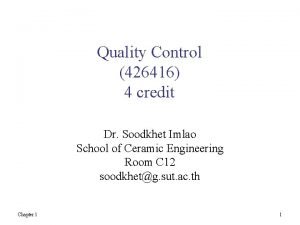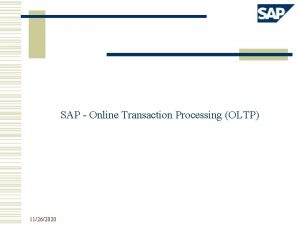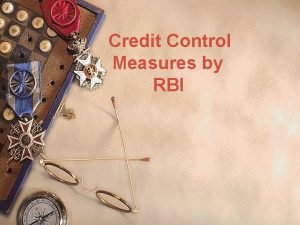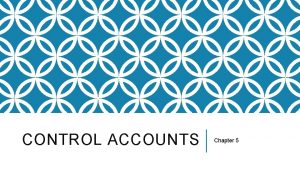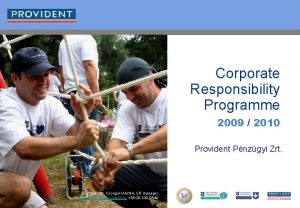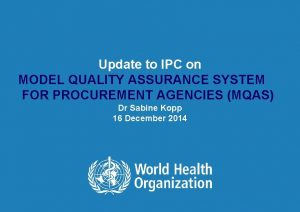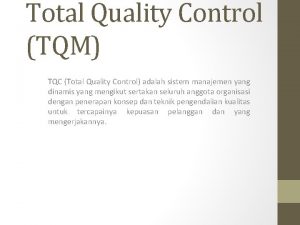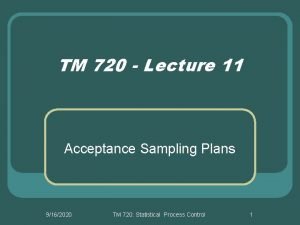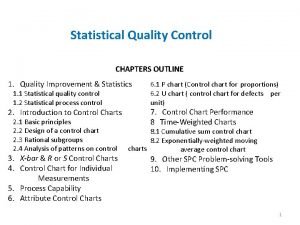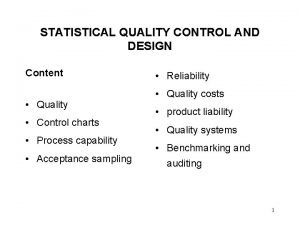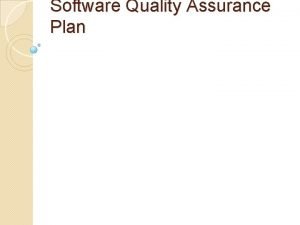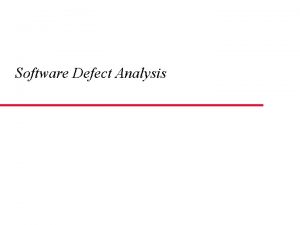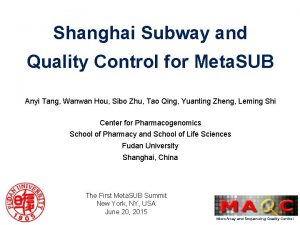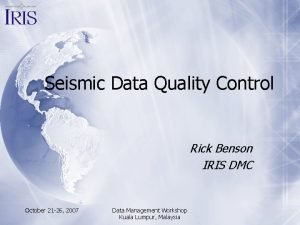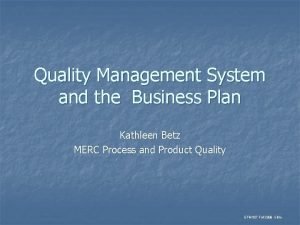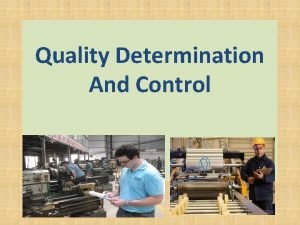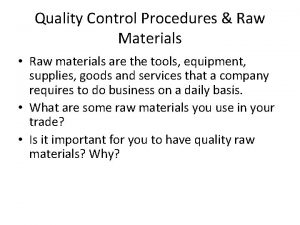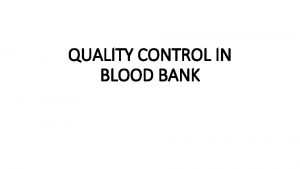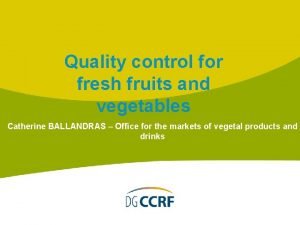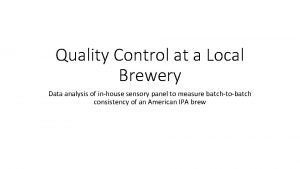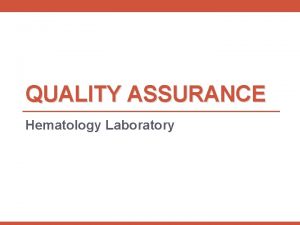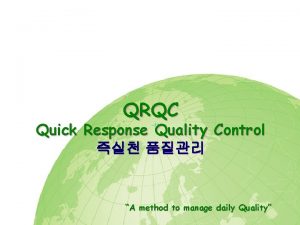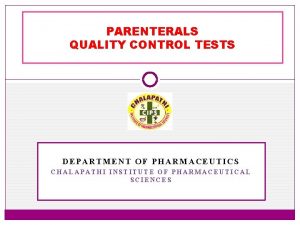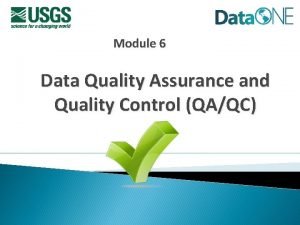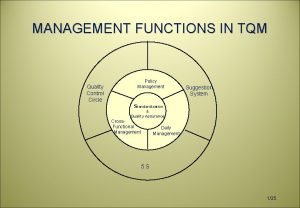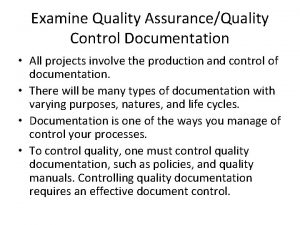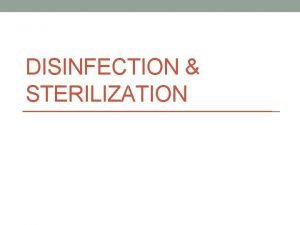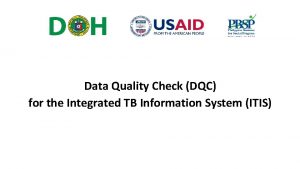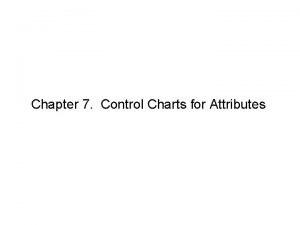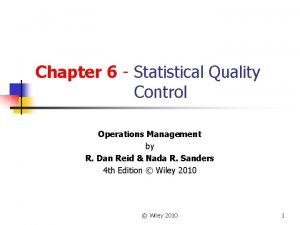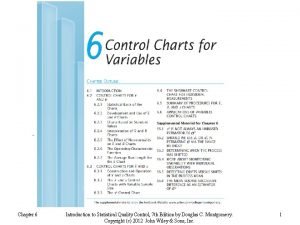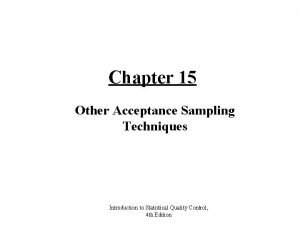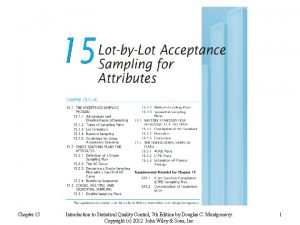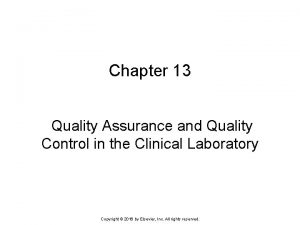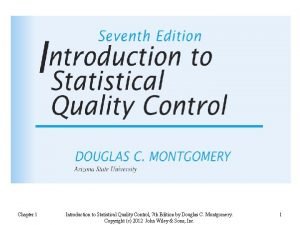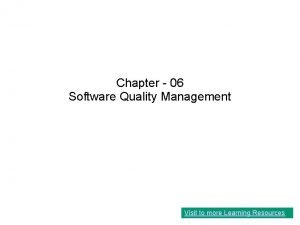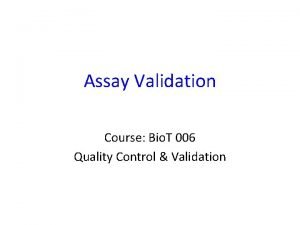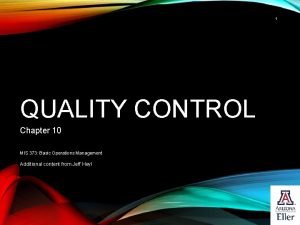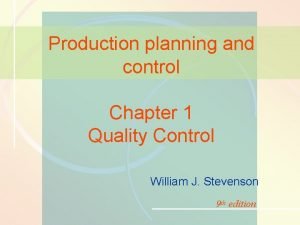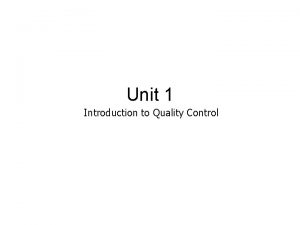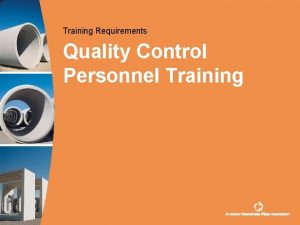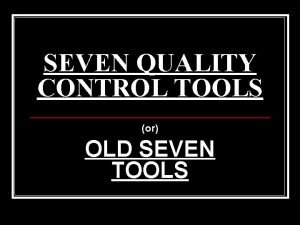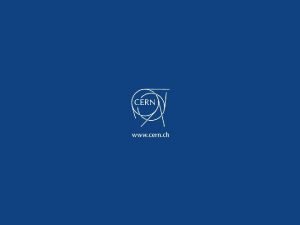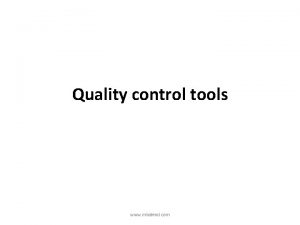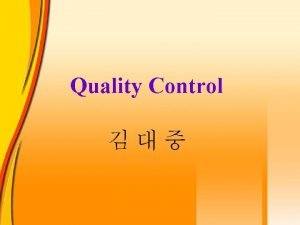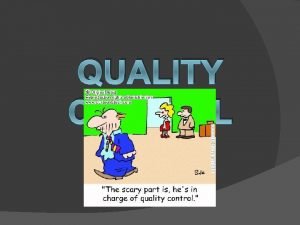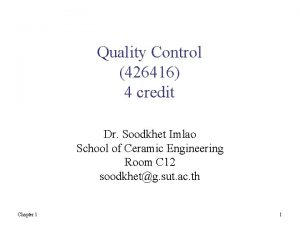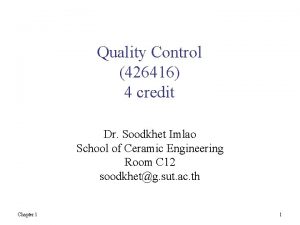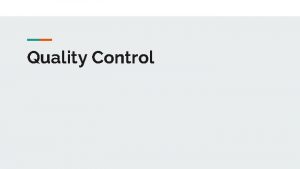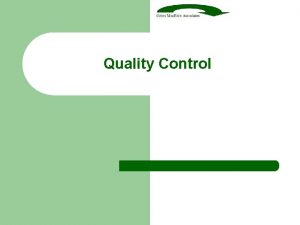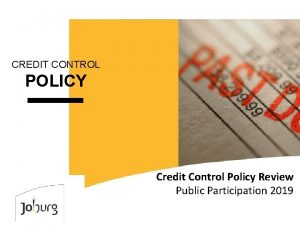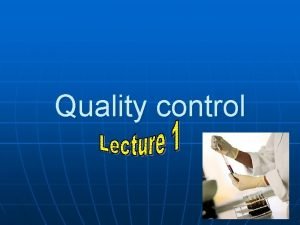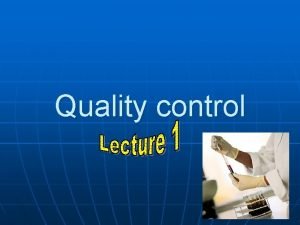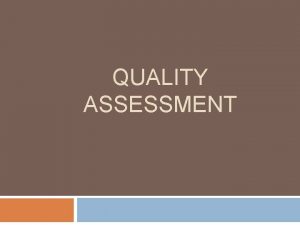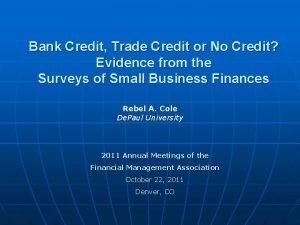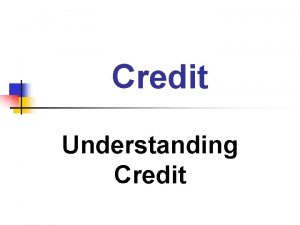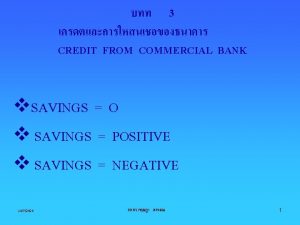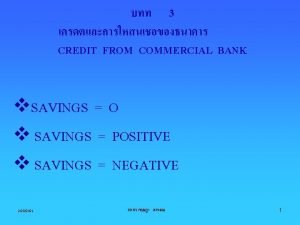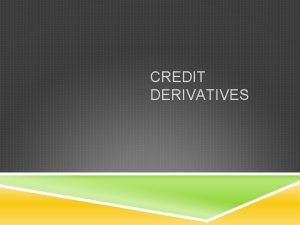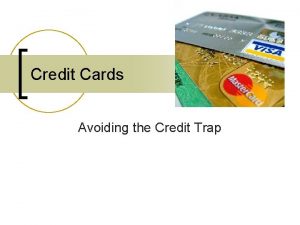Quality Control 426416 4 credit Dr Soodkhet Imlao
























































- Slides: 56

Quality Control (426416) 4 credit Dr. Soodkhet Imlao School of Ceramic Engineering Room C 12 soodkhet@g. sut. ac. th Chapter 1 1

Introduction to Quality Control Chapter 1 2

Learning Objectives • Define and discuss quality and quality improvement )อภบายเกยวกบคำจำกดความของ คณภาพและ การปรบปรงคณภาพ ( • Define and discuss costs of quality )อภบายเกยวกบตนทนของคณภาพ ( • Discuss the different dimensions of quality )อภบายเกยวกบมตของคณภาพ ( • Discuss the quality management philosophies of W. Edward Deming, Joseph M. Juran, and Armand V. Feigenbaum )อภบาย ปรญญาของการจดการคณภาพ ( • Explain the Shewhart cycle or Deming wheel (PDCA) • Discuss the three functions: quality planning, quality assurance, and quality control and improvement) อภบายเกยวกบ การวางแผนคณภาพ การควบคมคณภาพและ การปรบปรงคณภาพ ( • Discuss quality standard system (ISO 9000)) อภบายเกยวกบ ISO 9000( Chapter 1 3 • Discuss a quality award (in Thailand)

• This is a traditional definition Q: แปลความหมายของ quality สำหรบ definition เปนภาษาไทยใหไดใจความ Chapter 1 traditional 4

This is a modern definition of quality Chapter 1 5


This is a modern definition of quality Q: แปลความหมายของ quality สำหรบ modern definition เปนภาษาไทยใหไดใจความ Chapter 1 7

The Consequences of Poor Quality • • Chapter 1 Loss of business Liability Productivity Costs 8


Costs of Quality (continued) Prevention Costs – All TQ training, TQ planning, customer assessment, process control, and quality improvement costs to prevent defects from occurring • Appraisal Costs – Chapter 1 Costs of activities designed to ensure quality or discover defects : inspection 10

Costs of Quality (continued) • Internal Failure Costs – Costs incurred to fix problems that are detected before the product/service is delivered to the customer. • External Failure Costs – Chapter 1 All costs incurred to fix problems that are detected after the product/service is delivered to the customer. 11

Matching game 1 A B 2 3 C D 4 Chapter 1 12


• The transmission example (Fig. 2 in page 6) illustrates the utility of this definition • An equivalent definition is that quality improvement is the elimination of waste. การพฒนาคณภาพคอการลดความแปรปรวนของกระบวนการและผลตภณฑ หรอคอการกำจดสวนทเสย Variation or waste Chapter 1 14

Terminology )คำศพททใชใน QC) Chapter 1 15

Terminology )คำศพททใชใน QC) • Specifications – Lower specification limit – Upper specification limit – Target or nominal values • Defective or nonconforming product )ผลตภณฑทไมเปนไปตามมาตราฐานทกำหนดไว ( • Defect or nonconformity )สงทเปนจดตำหนหรอขอบกพรองในผลตภณฑ ( • Not all products containing a defect are necessarily defective Chapter 1 16

Dimensions of Quality 1. Performance )สมรรถภาพ)- main characteristics of the product/service 2. Aesthetics )รปลกษณ ความสวยงาม, สนทรยภาพ )appearance, feel, smell, taste 3. Special Features )รปลกษณพเศษ ) - extra characteristics 4. Conformance )ความถกตองตามสเปกทกำหนด )- how well product/service conforms to standard or customer’s expectations 5. Reliability) ความนาเชอถอของผลตภณฑ )consistency of performance Chapter 1 17

Dimensions of Quality (Cont’d) 6. Durability )ความทนทาน)- useful life of the product/service 7. Perceived Quality )ความมชอเสยงดานคณภาพ )- indirect evaluation of quality (e. g. reputation) 8. Serviceability - service after sale Chapter 1 18

Examples of Quality Dimensions Chapter 1 19

Examples of Quality Dimensions (Cont’d) Chapter 1 20


Examples of Service Quality Dimension Examples 1. Convenience Was the service center conveniently located? 2. Reliability Was the problem fixed? 3. Responsiveness Were customer service personnel willing and able to answer questions? 4. Time How long did the customer wait? 5. Assurance Did the customer service personnel seem knowledgeable about the repair? 6. Courtesy Were customer service personnel and the cashier friendly and polite? 7. Tangibles Were the facilities clean, personnel neat? Chapter 1 22

Case study of poor service quality control เจบปากไปผาตด -หมอชย ดนขรบจ ปท 60 ฉบบท 18629 วนพฤหสบด แมดช. 12โวยลน ท 22 มกราคม 2552 Question: discuss this case by considering service quality dimensions? Chapter 1 23

Case study of poor service quality control Chapter 1 24

History of Quality Improvement Work standard (Taylor) Assembly line (Ford) Control chart (Shewhart) Chapter 1 25

History of Quality Improvement QC in JP Deming Cause-andeffect diagram Ishigawa Chapter 1 26

History of Quality Improvement TQC ไฟเกนบวม QC in JP Juran Chapter 1 27


The Quality Gurus • • Chapter 1 Walter Shewhart W. Edwards Deming Joseph M. Juran Kaoru Ishikawa Armand Feigenbaum Taguchi Ohno and Shingo 29

Key Contributors to Quality Management Chapter 1 30

Walter A. Shewhart (1891 -1967) • Trained in engineering and physics • Long career at Bell Labs • Developed the first control chart about 1924 Chapter 1 31

W. Edwards Deming • Taught engineering, physics in the 1920 s, finished Ph. D in 1928 • Met Walter Shewhart at Western Electric • Long career in government statistics, USDA, Bureau of the Census • During WWII, he worked with US defense contractors, deploying statistical methods • Sent to Japan after WWII to work on the census Chapter 1 32

Deming’s 14 Points 1. Create constancy of purpose toward improvement 2. Adopt a new philosophy, recognize that we are in a time of change, a new economic age 3. Cease reliance on mass inspection to improve quality 4. Do not award business to suppliers on the basis of price alone, but also consider quality 5. Improve constantly and forever the system of production and service (focus on continuous improvement) 6. Practice modern training methods and invest in on-the-job training for all employees 7. Improve leadership, recognize that the aim of supervision is help people and equipment to do a better job 8. Drive out fear 9. Break down barriers between departments Chapter 1 33

Deming’s 14 Points 10. Eliminate slogans and targets for the workforce such as zero defects 11. Eliminate numerical work standards 12. Remove barriers that discourage employees from doing their jobs 13. Institute (start) a continuing program of education and selfimprovement 14. Create a structure in top management that will strongly support the first 13 points Chapter 1 14 ขอขางตนนเปนการมงเนนใหมการเปลยน แปลงในระดบองคกร และบทบาทของฝายบรหารมสวนสำคญมากในการเปล ยนแปลงองคกร 34

Shewhart cycle (or Demming wheel): The four steps; Plan-Do-Check-Act, are often called the PDCA cycle Chapter 1 35


Joseph M. Juran • Born in Romania (19042008), immigrated to the US • Worked at Western Electric, influenced by Walter Shewhart • Emphasizes a more strategic and planning oriented approach to quality than does Deming • Juran Institute is still an active organization promoting the Juran philosophy and quality improvement practices Chapter 1 37

The Juran Trilogy 1. Planning : design/develop products or services that meet customer needs 2. Control : to ensure the products or services meet the requirement (Statistical Process Control; SPC is one of the primary tools of cool) 3. Improvement: to achieve performance and quality levels that are higher than current levels Chapter 1 38

Armand V. Feigenbuam – Author of Total Quality Control, promoted overall organizational involvement in quality, – Three-step approach 1. quality leadership 2. quality technology (statistical methods) 3. organizational commitment Chapter 1 39

Statistical Methods for Quality Control and Improvement The major areas of quality control and improvement involving statistical methods are: • Statistical process control • Design of Experiment • Acceptance sampling Chapter 1 40

Statistical Methods • Statistical process control (SPC) – Control charts, plus other problem-solving tools – Useful in monitoring processes, reducing variability through elimination of assignable causes – On-line technique • Designed experiments (DOX) – Discovering the key factors that influence process performance – Process optimization – Off-line technique • Acceptance Sampling Chapter 1 41

Statistical process control (SPC) Walter A. Shewart (1891 -1967) • Trained in engineering and physics • Long career at Bell Labs • Developed the first control chart about 1924 Chapter 1 42

Designed experiments (DOX) Chapter 1 43

Acceptance Sampling Chapter 1 44

Management Aspects of Quality Improvement Effective management of quality requires the execution of three activities: 1. Quality Planning 2. Quality Assurance 3. Quality Control and Improvement Chapter 1 45

Chapter 1 46

Chapter 1 47

Chapter 1 48

Quality Systems and Standards Chapter 1 49

• The ISO certification process focuses heavily on quality assurance, without sufficient weight given to quality planning and quality control and improvement Chapter 1 50

Chapter 1 51

The Malcolm Baldrige National Quality Award • The MBNQA process is a valuable assessment tool • See Table 1 -3 for Performance Excellence Criteria and point values Chapter 1 52

Chapter 1 53

Chapter 1 54


Thai Quality Award Chapter 1 56
 Kano model of customer satisfaction
Kano model of customer satisfaction Perform quality assurance
Perform quality assurance Plan quality management pmp
Plan quality management pmp Quality metrics pmp
Quality metrics pmp Concept of quality assurance
Concept of quality assurance This can be avoided by giving credit where credit is due.
This can be avoided by giving credit where credit is due. Define credit control area in sap
Define credit control area in sap Quantitative credit control measures
Quantitative credit control measures Debtors control account debit or credit
Debtors control account debit or credit Limitations of credit control
Limitations of credit control Define quality assurance in nursing
Define quality assurance in nursing Compliance vs quality
Compliance vs quality Gurus of total quality management
Gurus of total quality management Quality is free
Quality is free What is tqm
What is tqm Mémoire inspe
Mémoire inspe Contoh tqc
Contoh tqc What is sampling plan in quality control
What is sampling plan in quality control Average run length in quality control
Average run length in quality control Define statistical quality control
Define statistical quality control Software quality assurance plans
Software quality assurance plans Quality control log examples
Quality control log examples Quality control shanghai
Quality control shanghai Rick benson iris
Rick benson iris Quality control system in business plan example
Quality control system in business plan example Determination and description of material quality
Determination and description of material quality Raw material quality control specifications
Raw material quality control specifications Whole blood quality control
Whole blood quality control Quality control of fresh fruits and vegetables
Quality control of fresh fruits and vegetables Quality control analysis of beer
Quality control analysis of beer Quality control in hematology
Quality control in hematology Quick response quality control
Quick response quality control Clarity
Clarity What is quality control definition
What is quality control definition Functions of tqm
Functions of tqm Quality control documentation
Quality control documentation Chemical indicator for system 1e
Chemical indicator for system 1e Dqc data quality control
Dqc data quality control Defect chart
Defect chart Statistical quality control in operations management
Statistical quality control in operations management Average run length in quality control
Average run length in quality control What is sampling plan in quality control
What is sampling plan in quality control What is sampling plan in quality control
What is sampling plan in quality control Westgard rules
Westgard rules Montgomery quality control
Montgomery quality control Six sigma methodology defines three core steps
Six sigma methodology defines three core steps Quality control assay
Quality control assay Asq control chart
Asq control chart Quality control chart
Quality control chart Introduction to quality control
Introduction to quality control Quality control personnel
Quality control personnel Aec quality control
Aec quality control Seven quality control tools
Seven quality control tools Quality control approved by rf
Quality control approved by rf Mbaknol.com
Mbaknol.com Third party quality control
Third party quality control Quality v
Quality v
